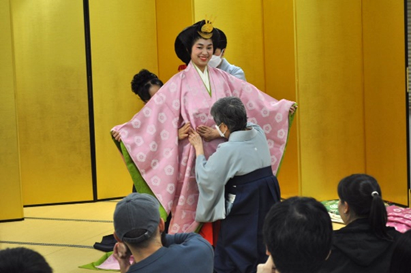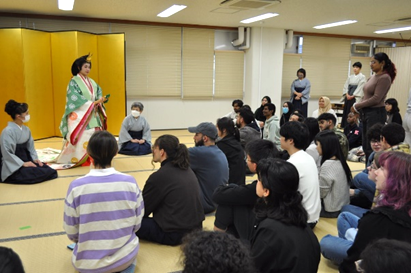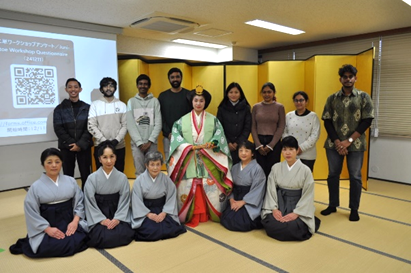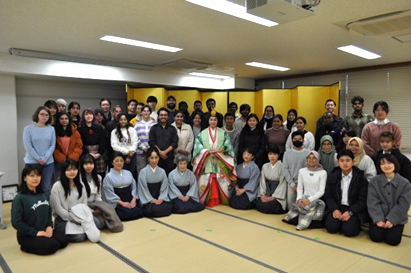Japanese Culture Workshop - Juni hitoe (Twelve layered kimono) 2024
The Center for Japanese Language and Culture (CJLC) held a 'Japanese Culture Workshop - Juni hitoe1 (Twelve layered kimono) 2024' on Wednesday, December 11, 2024, in the Center's Japanese-style tatami room.
On the day of the event, over 50 participants attended, including students at the Winter School program coming from the Indian Institute of Technology Guwahati, India and the National University of Malaysia, Malysia, as well as international students studying the Japanese Language and Culture Studies Course, and the Japanese Society and Culture Program at CJLC, international and Japanese students, faculty and staff members of Gifu University.
At the workshop, instruction was provided by five instructors, including Ms. ITO Keiko (professional alias: Houshoukei), who specializes in kimono dressing. There was also a live koto harp performance, which conveyed the charm of the Juni hitoe in a solemn and elegant atmosphere. Additionally, Professor TSUCHIYA Momoko from the CJLC gave an explanation of Japanese history and the basics of the Juni hitoe in both Japanese and English.
Following this, Ms. Tran Thoa Thi Kim, a Japanese Language and Culture Studies Course student from Vietnam who was selected from among the volunteers for the dressing model, entered the room wearing a kosode2 and nagabakama3, with her makeup prepped.
The instructors, showing respect to Ms. Tran as 'Okata-sama4' in accordance with the etiquette, dressed her in layers of garments in the order of 'hitoe,' 'itsutsuginu,' 'uwagi, karaginu,' and 'mo.' Participants asked many questions, such as "Did people wear the Juni hitoe every day?" "How were they stored?", and "How did they manage bathroom breaks?" to which the instructors provided detailed explanations.
The Juni hitoe can be easily slipped off while maintaining its layered form. This is called "Utsusemi." Participants, regardless of gender, stepped inside this Utsusemi, felt its weight, and enjoyed taking pictures with their friends.
Participants shared that they were able to appreciate the depth and beauty of traditional Japanese culture, making it a meaningful opportunity that contributed to the enrichment of Japanese cultural education.
Gifu University will continue to provide better experiences where participants can enjoy and understand Japanese culture, enhancing Japanese cultural education.
1) a traditional Japanese court attire worn by noble women during the Heian period (794 to 1185). It consists of multiple layers of silk robes, typically twelve, and is known for its elegance and intricate color combinations.
2) a traditional Japanese garment with small sleeve openings
3) a type of traditional Japanese trousers with long, trailing legs that cover the feet and extend into a train at the back
4) a respectful term used to address a noble or high-ranking person











